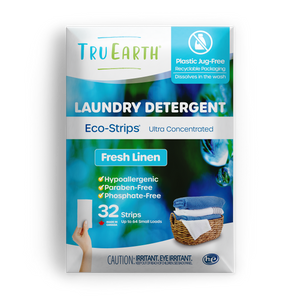Let’s all collectively admit, paper towels can be a hard habit to quit.
I’ll go first.
I’m a parent to a toddler and 1.5-year-old twins. Every waking minute, sticky hands explore anything that can be grasped or climbed, spills happen at a mile a minute and food spends just as much time on a plate as the floor.
Paper towel is almost a first instinct. They’re double-duty heroes when it comes to spills, absorbing liquids and wiping away residue in one fell swoop. Always within reach, they’re handy kitchen helpers. But every time I peel a sheet off the roll (or two, or three – they’re easy to overuse), that hard-to-ignore feeling hits me: paper towels are unequivocally a single-use item.
Enter the Swedish dishcloth, a clever product that marries the scrubbing quality of a sponge (minus the bacteria, ew) with the convenience paper towel and the absorbency of a dish towel. And people love them – not just parents. A quick Amazon search reveals tens of thousands of 4.5-star reviews. Here, we explain the hype.
What are Swedish dishcloths made of?
Swedish dishcloths are made of wood-derived cellulose, often times blended with a minority percentage of cotton. Thanks to these organic fibres, Swedish dishcloths are 100% biodegradable. That’s right, they go in the compost, not the garbage.
Caveat: Do not compost a Swedish dish cloth without cleaning it first. Just like recycling, items must be free of food debris, grease or chemicals before entering a blue bin or compost.
Are Swedish dishcloths really Swedish?
Indeed. In 1949, Swedish engineer Carl Lindquist discovered the incredible absorbency of cellulose. How absorbent? A Swedish dishcloth can mop up 15 times its weight in water. To visualize, one dry cloth can absorb about three-quarters of a cup of liquid.
Reasons to love Swedish dishcloths

Swedish dishcloths are the Swiss Army knife of household cleaning; a multi-tool, so to speak, that will replace a litany of products including sponges, paper towels, traditional dishcloths and microfibre rags. When dry, they absorb messes. When wetted, the cloths become soft and pliable, safe to use on a variety of surfaces from wood to stone. Mist one with a cleaning solution to tackle bathtubs and sinks, and even mirrors and windows. (Yep, they produce a streak-free clean.) In the kitchen, they’re tough enough to wipe down a stove top or tackle pots and pans – without the worry of abrasion or tearing. The versatility of a Swedish dishcloth is immense, the applications limitless. Heck, you might even find yourself washing the car with them.
Will Swedish dishcloths produce a funky smell?
The longer a wet textile like a dishtowel or rag sits, the more time bacteria are given to develop an odor. Since Swedish dishcloths begin to dry after a quick squeeze and hang, they’re less prone to smell.
How do I wash a Swedish dishcloth?
For something primarily constructed of a plant-based material, Swedish dishcloths are surprisingly hardy. To wash, simply toss in the top rack of a dishwasher or launder in a washing machine – and importantly – hang to dry. A frequently used Swedish dishcloth should last from two to three months at the very least, but generally from six-to-nine months. That’s about 200 uses. To sterilize, let the cloth sit in hot-boiled water for two minutes or microwave a damp cloth for 60 seconds.
How to prolong the life of a Swedish dishcloth
 Tru Earth Swedish Dishcloth
Tru Earth Swedish Dishcloth
- Never dry in the dryer, always hang-dry
- Do not leave them sitting wet on flat surfaces
- Best not to wring tightly; squeeze, instead
- Take care not to slice the material when washing items with sharp edges like knives, can openers or cheese graters.
- White or light hued cloths will discolour with time, especially in the kitchen (think: coffee rings and tomato sauce), so rinse promptly after use. Bleach can be used sparingly but will reduce the longevity of the cloth.
Tip: If you intend to use your Swedish dishcloths for different functions (bathroom, kitchen, etc.), consider colour-coding your collection. Example: blue for bathrooms, green for dishes, pink for surfaces. This way, you won’t confuse the cloth that cleans the toilet bowl or your pet’s feet for the one you wash your cutting board with.
Will Swedish dishcloths save me money?

If you’ve read to this point and the environmental cause for switching to Swedish dishcloths isn’t enough to hit “add to cart,” perhaps the dollars-and-cents math is.
Consider a two-pack of paper towel that costs $6.00. If one Swedish dishcloth costs approximately $4 and replaces 17 rolls (or, $51 dollar’s worth of paper towel), you’re saving $47 on just your first Swedish dish cloth.
We think that’s a win-win-win for the wallet, home and planet.


